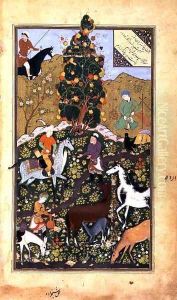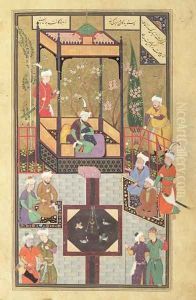Mir Ali Al Husayni Paintings
Mir Ali Al Husayni was a prominent calligrapher from the 16th century, whose life details, including his exact birth year, remain largely unknown beyond the broad strokes of his contributions to the art of calligraphy. He lived during the Safavid era, a time when Persia was experiencing a significant cultural and artistic renaissance. This period was marked by a flourishing of the arts, especially calligraphy, which was considered not just a means of communication but an important artistic expression that was deeply intertwined with the spiritual and intellectual life of the society.
Mir Ali Al Husayni is best known for his mastery of the Nasta'liq script, which is characterized by its beauty, elegance, and fluidity. This script became the dominant style for Persian calligraphy under the Safavids and was also widely used in the Ottoman and Mughal empires. It is particularly associated with the writing of poetry, an art form that was highly esteemed in Persian culture. Mir Ali's work is distinguished by its precision, creativity, and the emotional depth he brought to the script, which elevated the written word to new artistic heights.
Throughout his career, Mir Ali Al Husayni produced numerous works that have been praised for their aesthetic qualities and technical excellence. His reputation was such that he was appointed as a royal calligrapher, a position that allowed him to work on significant commissions and contribute to the beautification of manuscripts and architectural projects. Despite the lack of detailed records about his life, his legacy lives on through his surviving works, which continue to be studied and admired for their artistic and historical significance.
Mir Ali Al Husayni's death in 1544 marked the end of an era for Persian calligraphy, but his influence persisted. He trained several students who carried on his techniques and styles, ensuring the continuation of the traditions of Nasta'liq script. Today, he is remembered as one of the greatest calligraphers of his time, and his works are considered treasures of Islamic art. They serve not only as a testament to his skill and vision but also as a window into the rich cultural heritage of the Safavid era.

